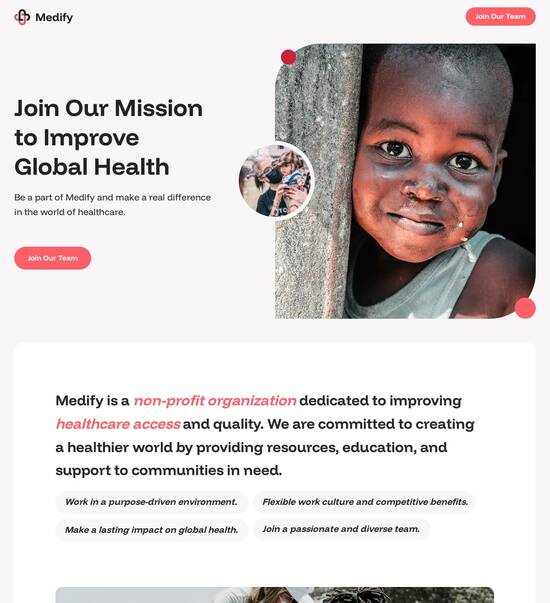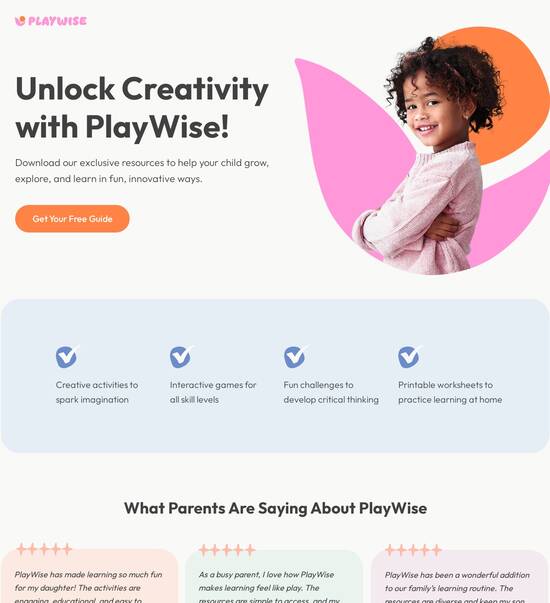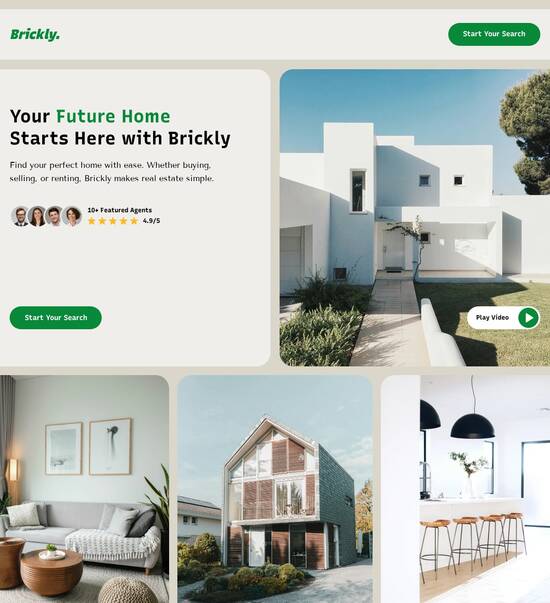
PWA weather forecast website template
Explore Similar TemplatesAbout template
Drive more leads with Instapage PWA weather forecast website template built to maximize conversions. Easy customization - no designer or coding skills needed.
Recommended templates

Easy to build without coding
With the intuitive drag-and-drop builder, anyone on your team can create high-converting pages without any knowledge of code or design. Make enhancements to your landing page with custom widgets using Javascript, HTML/CSS, or third-party scripts.

Multiple layouts for any industry and goal
Select from 500+ landing page layouts built to boost conversions across industry-specific scenarios. Customize them by adjusting fonts, adding images, and generating on-brand content with the AI assistant. Quickly scale with Instablocks® and Global Blocks that you can save, reuse, and update globally.

Loads fast and looks polished on any device
Every template is responsive, which means they present professionally on any device and load blazingly fast with our Thor Render Engine. You can also power them up with Google AMP technology to deliver an unparalleled mobile experience and drive higher conversions.

Robust analytics & experimentation
Get real-time updates and reporting across all your devices, showing the number of visitors, conversions, cost-per-visitor, and cost-per-lead. Launch AI-powered experiments, run A/B tests, and use heatmaps to analyze user behavior, then optimize your landing page to maximize conversions.







Easy to build without coding
With the intuitive drag-and-drop builder, anyone on your team can create high-converting pages without any knowledge of code or design. Make enhancements to your landing page with custom widgets using Javascript, HTML/CSS, or third-party scripts.
Multiple layouts for any industry and goal
Select from 500+ landing page layouts built to boost conversions across industry-specific scenarios. Customize them by adjusting fonts, adding images, and generating on-brand content with the AI assistant. Quickly scale with Instablocks® and Global Blocks that you can save, reuse, and update globally.
Loads fast and looks polished on any device
Every template is responsive, which means they present professionally on any device and load blazingly fast with our Thor Render Engine.
Robust analytics & experimentation
Get real-time updates and reporting across all your devices, showing the number of visitors, conversions, cost-per-visitor, and cost-per-lead. Launch AI-powered experiments, run A/B tests, and use heatmaps to analyze user behavior, then optimize your landing page to maximize conversions.
All the features you need to build lead-generating landing pages
Explore more featuresLearn how to build top-performing landing pages for any goal
FAQs
Leading the way in building high-performing landing pages





A step-by-step guide to optimizing your campaigns with Instapage
In the competitive landscape of digital marketing, optimizing your campaigns is crucial for improving ROI. Instapage serves as a powerful landing page and conversion rate optimization (CRO) platform that provides marketers with the essential tools to launch, optimize, and scale campaigns effectively. This guide will walk you through the steps to create high-performing landing pages and leverage features that can dramatically enhance your marketing efforts.
Understanding Instapage's features for effective landing page creation
Instapage simplifies landing page creation with an intuitive interface. You have access to over 100 ready-to-use templates, making it easy to craft high-converting pages. The platform's drag-and-drop functionality allows marketers to customize layouts without needing coding skills, facilitating faster page launches. By using these templates, businesses in various verticals such as tech, education, and financial services can ensure that they capture leads effectively.
- Access to a library of 100+ high-converting templates tailored for various industries, enabling you to optimize your lead generation strategies.
- Utilize pre-built lead generation elements like forms and buttons to enhance your pages, ensuring they align with your marketing objectives.
- Leverage the drag-and-drop editor for a seamless design experience, reducing the reliance on developer resources and shortening time to market.
Optimizing your landing pages for greater conversions
Once your pages are built, optimization becomes key for improving conversion rates. Instapage offers built-in experimentation tools and detailed analytics to help you understand user behaviors. Features like A/B testing and heatmaps allow marketers to identify which variations of their landing pages perform better.
- Use heatmaps to visualize user interactions on your landing pages, helping you identify key areas to improve for better engagement.
- Conduct A/B tests to analyze variations of headlines, images, and call-to-action buttons, optimizing based on quantifiable data.
- Regularly assess performance using the analytics dashboard, allowing you to make informed decisions while adapting your strategies.
Personalizing content for targeted audience engagement
Personalization is crucial in today’s marketing landscape. Instapage allows you to create tailored experiences for different audience segments. Tools like dynamic text replacement ensure that your messaging resonates with specific visitor demographics by aligning ads to the targeted landing pages.
- Implement dynamic text replacement to customize landing page copy based on the source of your traffic, enhancing visitor relevance.
- Utilize AdMaps to align specific advertising campaigns with unique landing pages, providing a coherent user experience.
- Track audience-level metrics using data tools to further refine your personalization strategies based on performance insights.
By following these steps and utilizing the features of Instapage effectively, marketers can expect to see increased engagement and higher conversion rates from their campaigns.
To ease the page production process, Instapage's collaboration features facilitate teamwork, enabling real-time feedback and edits. This accelerates the workflow, allowing you to focus on strategy and results. Effective collaboration can significantly reduce the time taken to launch optimized pages.
Start optimizing your digital marketing campaigns today with Instapage. Sign up now to unlock powerful features that will revolutionize your landing page strategies!
People also ask about PWA weather forecast website template
PWA weather forecast website template: Comprehensive guide for developers and marketers
Understanding progressive web apps (PWAs)
Progressive Web Apps, or PWAs, represent an innovative blend of web and mobile app features. They leverage modern web capabilities to deliver a native mobile app-like experience directly through a browser. The core principles of PWAs include reliability, speed, and engagement, making them an attractive choice for users and developers alike.
One of the significant advantages of PWAs is that they offer a seamless user experience across various platforms without requiring users to download a separate application. Users enjoy faster loading times, offline capabilities, and push notifications all through their browsers. Unlike traditional web applications, which often suffer from slow loading and lack of engagement, PWAs provide a more interactive experience.
The key component of a PWA is the service worker, which acts as a proxy between the web app and the network. This enables caching of assets and data, allowing users to access essential functions even without an internet connection. Furthermore, PWAs ensure accessibility across a range of devices, from desktops to smartphones, enhancing usability for diverse audiences.
Key features of a PWA weather forecast website template
When creating a PWA weather forecast website template, several features stand out as essential. One of the cornerstones is real-time weather data integration, usually achieved through APIs that provide the latest weather updates and forecasts. Utilizing services like OpenWeatherMap or WeatherAPI enables developers to fetch location-based data efficiently.
Real-Time Weather Data Integration: Automatically fetches updated weather data from reliable APIs for various locations.
Offline Functionality and Caching: Service workers ensure access to critical features even when offline, improving user experience during outages.
Responsive Design: Mobile-first strategies guarantee fluid layouts and easy navigation across devices.
Push Notifications: Users can receive alerts for severe weather conditions or personalized updates based on their location.
Responsive design is crucial for usability across diverse devices. This means incorporating fluid grids and flexible images to accommodate various screen sizes and resolutions. Finally, push notifications can significantly enhance user engagement, providing timely weather alerts that keep users informed in real time.
Technological framework behind the template
A PWA weather app template relies heavily on modern frontend technologies. For instance, HTML, CSS, and JavaScript play pivotal roles in the development. Developers often choose frameworks like React or Vue.js for building interactive interfaces that ensure high performance and user satisfaction.
Frontend Technologies: HTML, CSS, JavaScript, and frameworks like React and Vue.js facilitate a smooth user experience.
Backend Services and APIs: Server-side technologies manage data efficiently while maintaining API security and handling rate limits.
Database Management: Local storage or cloud databases help retain user preferences, ensuring settings are synchronized across devices.
On the backend, managing data effectively through server technologies is key. Developers must also prioritize API security and respect rate limits to ensure that users receive accurate and timely data without overwhelming the API. Moreover, database management for user preferences, either through local storage or cloud solutions, facilitates a streamlined experience across different devices.
Building community through user engagement
User engagement is fundamental for the success of a PWA weather forecast website template. One effective strategy is allowing users to contribute localized weather observations, creating a rich database of real-time data. This user-generated content enriches the app's credibility and enhances interaction among users.
User-generated Content Contributions: Facilitates sharing local observations of weather events by users.
Social Media Integration: Sharing features that encourage users to disseminate forecasts and alerts on their social networks.
Collaboration with Meteorological Collectives: Form partnerships with local weather stations for accurate data.
Incorporating social media sharing options allows users to broadcast weather alerts and updates with ease, further enhancing engagement. Additionally, collaborating with meteorological organizations can significantly improve data accuracy and provide users with valuable insights, fostering a sense of community around weather discussions.
Example applications of PWA weather forecast templates
Real-world applications of PWA weather forecast templates provide valuable insights into their functionality and engagement potential. For example, implementing a local weather app may involve utilizing geographic data to provide personalized forecasts for users based on their location. This targeted approach can result in higher user interaction and satisfaction.
Case Study: Local Weather App Implementation: Utilizing localized data for tailored user experiences.
Comparison of Popular Weather PWAs: Analyzing existing applications’ strengths and weaknesses.
Comparing various successful PWAs reveals their unique features and innovations. Studying these applications highlights the common elements that resonate with users, providing valuable lessons for developers aiming to create competitive weather applications.
Answering key questions about PWA weather forecast websites
Understanding what makes PWAs superior for weather applications involves recognizing their performance, reliability, and user retention capabilities. Users prefer fast, reliable experiences, especially for essential information like weather forecasts. PWAs meet these demands while reducing overhead costs associated with traditional app development.
What makes PWAs superior for weather applications? Performance benefits and enhanced user retention.
How do PWAs handle updates and maintenance? Ensuring ongoing relevance through regular optimizations.
What are the best practices for designing a user-centric weather app? Key UI considerations and accessibility features.
Maintaining relevance involves implementing ongoing updates and optimizations. Developers must gather data on user behavior to adapt the application accordingly, ensuring that the app meets user expectations and leverages emerging technologies in the process.
Insights into user behavior and interaction with weather data
Incorporating analytics effectively allows developers to collect valuable insights regarding user preferences and behaviors. By utilizing analytic tools, developers can examine how users interact with different features, allowing for targeted improvements that enhance the overall experience.
Collecting User Preferences and Analytics: Gathering insights to tailor features.
Improving User Experience through A/B Testing: Testing different designs and functionalities for optimal results.
A/B testing techniques help determine which design elements resonate with users, leading to continuous refinements. Feedback loops created through user engagement not only inform development but also foster a sense of community around the weather forecast application.
Innovative solutions for teams developing PWA templates
The success of a PWA weather forecast template relies on collaborative efforts among development teams. To maximize productivity, project management tools can be utilized to streamline tasks and enhance communication amongst team members. Version control systems play a vital role in managing changes and ensuring collaboration.
Collaboration Tools: Optimize team workflows with effective project management tools.
Knowledge Sharing Across Development Communities: Foster environments of collaboration for shared learning.
Creating a culture of knowledge sharing encourages team members to learn from one another and develop their skills. Accessing forums and online communities also facilitates troubleshooting, creating a support system for developers tackling common challenges.
Previewing future trends in weather forecast PWAs
As technology evolves, weather forecast applications will increasingly integrate emerging technologies such as artificial intelligence and machine learning. These innovations offer significant opportunities for predictive analytics that can enhance the user experience by providing users with more accurate forecasts based on historical data patterns.
Emerging Technologies Impacting Forecast Applications: AI and machine learning for predictive analytics.
Potential Developments in User-Experience Mechanisms: Expected improvements in design trends and user engagement strategies.
Environmental Concerns and Sustainable Practices: The role of apps in raising awareness of climate issues.
The development of user experience mechanisms will continue to evolve, encouraging ongoing innovation in app design and functionality. Additionally, educating users about environmental concerns related to weather patterns will create an opportunity for weather applications to contribute positively to climate awareness.
Research and facts supporting the PWA approach
Numerous industry reports underscore the benefits of implementing PWAs for various applications, including weather forecasts. Key statistics illustrate a growing trend toward PWA adoption, highlighting improvements in user engagement and retention rates associated with these applications.
Citations of Industry Reports on PWA Benefits: Statistics reflecting growth and user adoption rates.
How User Demographics Influence Weather App Development: Understanding user personas for tailored features.
Notable Success Stories and Facts from Top Weather PWAs: Highlighting effective use cases in the industry.
Understanding user demographics allows developers to create experiences that resonate with their audience. Notable success stories from top weather PWAs serve as case studies for new developers looking to harness the power of PWA technology.
Ready to skyrocket conversions?
Supercharge your ad campaigns with high-performing landing pages
Get started














